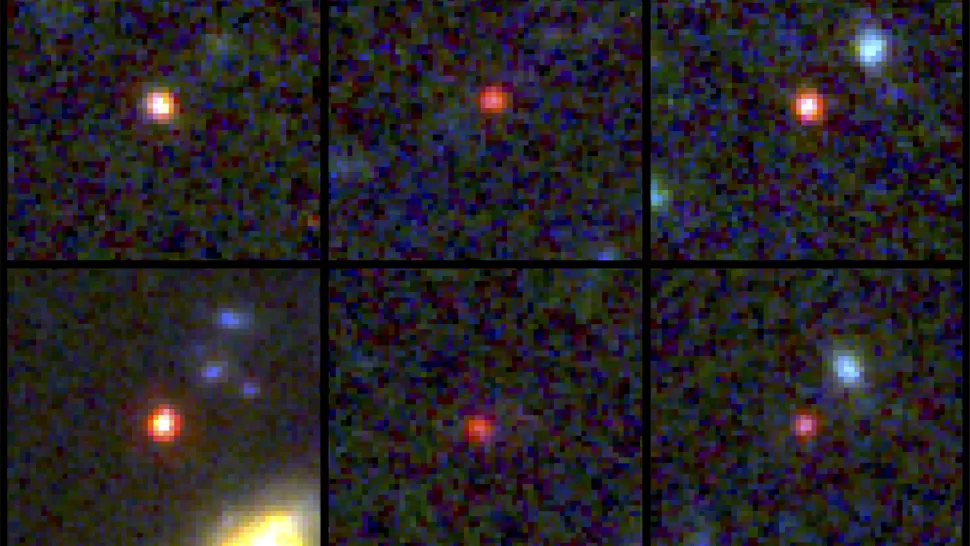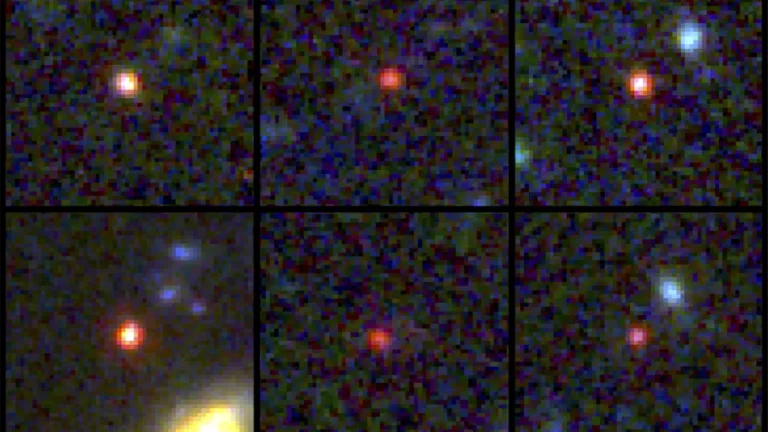James Webb Space Telescope’s discovery challenges current understanding of galaxy formation.
Giant, mature galaxies seem to have filled the universe shortly after the Big Bang, and astronomers are puzzled.
Unexpected and unexplainable, massive galaxies containing mature red stars have been discovered by the James Webb Space Telescope (Webb or JWST) during its early observation campaign, leaving astronomers puzzled.

These galaxies, which are almost as massive as the Milky Way, were found in deep field images obtained by Webb and are described in a new study based on its first data release. Despite appearing as tiny reddish dots to the powerful telescope, astronomers were able to establish that they were viewing these galaxies in our universe’s infancy, only 500 to 700 million years after the Big Bang.
Although early galaxies are not surprising, as star clusters were expected to form shortly after the universe moved out of the dark ages, the mature red stars found in these distant galaxies have yet to be explained.
The size and age of the galaxies discovered in the images captured by the Webb telescope were unexpectedly large and mature, which contradicts current theories about the early universe and conflicts with previous observations made by the less powerful Hubble Space Telescope. These findings are perplexing astronomers and challenging their understanding of the formation and evolution of galaxies.
“We had specific expectations for the type of galaxies that live in the early universe: they are young and small,” Joel Leja, assistant professor of astronomy and astrophysics at Penn State and one of the authors of the study, told Space.com in an email. “Previous studies of the early universe with Hubble and other instruments tend to find small, blue, baby galaxies at early times: objects which have just recently formed out of the primordial cosmic soup and are themselves building their early stars and structures.”
Normally, young stars emit blue light, while older stars appear redder as they consume their fuel and cool down. In the case of ancient galaxies that the Webb telescope was designed to detect, astronomers anticipated that they would only see young, blue stars. Additionally, they did not expect to observe galaxies that were larger than one billion suns. However, the tiny red dots spotted in Webb’s deep fields revealed galaxies that are approximately 50 times more massive than that, according to Leja.
“The most massive galaxies in our sample are estimated to have masses [two to four times lower] than that of our own Milky Way,” Leja wrote. “This was astounding — we’re finding galaxy candidates as massive as our own galaxy when the universe was 3% of its current age.”
According to Leja, astronomers will need to confirm that the unusual reddish dots they are observing are not something else before they can begin to revise cosmological theories to account for the rapid formation of these galaxies after the Big Bang. Nonetheless, Leja noted that most of the other possible explanations would also necessitate the introduction of completely novel concepts.
“For example, stars in the early universe might emit light in exotic ways due to their lack of heavy elements, and perhaps we’re not incorporating those in our models,” Leja wrote. “Or alternatively, perhaps our understanding of how stars form locally, e.g. how many stars form from gas as a function of the mass of the stars, is totally inapplicable in the early universe. These things would also be exciting to discover and would also overturn our understanding of star formation in the early universe — just in a very different way.”
The James Webb Space Telescope captured the images of these perplexing galaxies using its Near Infrared Camera (NIRCam) as a component of the Cosmic Evolution Early Release Science (CEERS) program. To gain more insight into these distant dots, astronomers intend to point Webb’s mirror towards these galaxies once again and acquire light spectra. Spectra split the observed light based on its wavelength composition, exposing the chemical and physical characteristics of its origin.
“The most important thing is that spectra give very precise distances to these objects,” said Leja. “The “distance” and the “identity” of these objects is correlated: if we know the distance, we can pin down the identity, and vice versa. So a spectrum will pretty immediately tell us if our hypotheses are correct.”
The first observations from the James Webb Space Telescope were released just over six months ago, and scientists are already facing a challenge to revise their theories regarding the early universe.
“We looked into the very early universe for the first time and had no idea what we were going to find,” Leja said in a Penn University statement. “It turns out we found something so unexpected it actually creates problems for science. It calls the whole picture of early galaxy formation into question.”
The study was published in the journal Nature on Wednesday (Feb. 22).
Do not forget to share your opinion with us to provide you with the best posts !





0 Comments